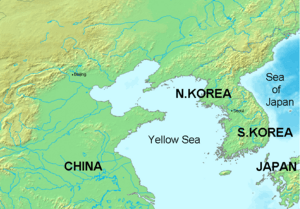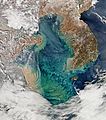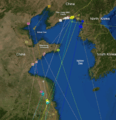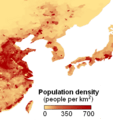Yellow Sea facts for kids
The Yellow Sea is a part of the Pacific Ocean. It is located between Mainland China and the Korean Peninsula. You can find it north of the East China Sea. The northwestern part of the Yellow Sea is known as the Bohai Sea.
The sea gets its name, "Yellow Sea," from the tiny bits of silt that flow into it. These silt particles come mostly from the Yellow River in China. Other rivers like the Yalu River and the Han River also add water and sediment to the sea.
Contents
Why is the Yellow Sea Yellow?
The Yellow Sea gets its unique color from the huge amount of silt and sand carried by rivers. The most important river for this is the Yellow River (also called Huang He). This river picks up a lot of yellowish-brown soil as it flows through China. When the river reaches the sea, it dumps all this sediment into the water, making it look yellow or brownish-yellow.
What is Silt?
Silt is like very fine sand or mud. It's made of tiny pieces of rock and soil. When there's a lot of silt in the water, it can make the water look cloudy or murky. This is why the Yellow Sea isn't clear blue like some other oceans.
Where is the Yellow Sea Located?
The Yellow Sea is a large body of water in East Asia. It's bordered by:
- China to the west and north
- The Korean Peninsula (which includes South Korea and North Korea) to the east
It connects to the East China Sea in the south. The Bohai Sea is a smaller, almost enclosed bay at the very top (northwest) of the Yellow Sea.
Wildlife in the Yellow Sea
The Yellow Sea is home to many different kinds of plants and animals. Even though it's a busy area for shipping and fishing, many species live there.
Sea Animals
Many types of fish, crabs, and shellfish live in the Yellow Sea. Some common fish include cod, herring, and mackerel. You can also find different kinds of shrimp and clams. The sea is an important place for fishing, providing food for millions of people in China and Korea.
Birds and Migration
The Yellow Sea is a very important stop for many migratory birds. These birds travel thousands of miles between their breeding grounds in the north (like Siberia) and their winter homes in the south (like Australia and New Zealand).
The muddy shores and wetlands of the Yellow Sea provide a perfect place for these birds to rest and find food. Birds like the bar-tailed godwit and various types of sandpipers rely on the Yellow Sea's rich mudflats to refuel during their long journeys. Protecting these areas is crucial for the survival of many bird species around the world.
Human Impact on the Yellow Sea
The areas around the Yellow Sea are very densely populated, meaning many people live there. This has led to some challenges for the sea.
Pollution
With so many people and industries, the Yellow Sea faces pollution from cities and factories. This can harm the marine life and the overall health of the ecosystem. Efforts are being made to reduce pollution and keep the sea clean.
Fishing
Fishing has been a major activity in the Yellow Sea for centuries. However, sometimes too many fish are caught, which can reduce the number of fish for the future. Countries around the Yellow Sea are working together to manage fishing better so that fish populations can stay healthy.
Images for kids
-
Waves crashing at Jeju Province island
-
Brown sediment spills out into the Yellow Sea from rivers in eastern China and Korea. The nutrients in the sediment may be responsible for the bloom of phytoplankton seen as blue-green swirls.
-
Migration paths and resting grounds of bar-tailed godwit at the Yellow Sea.
-
A map of population density around the Yellow Sea in East Asia (1994)
See also
 In Spanish: Mar Amarillo para niños
In Spanish: Mar Amarillo para niños







